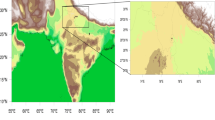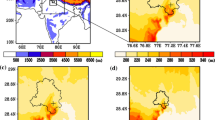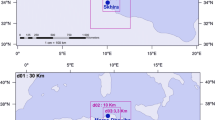Abstract
This study investigates the predictability of the dense advection fog over Istanbul on February 19, 2014, which significantly halted international as well as local transportation. Sensitivity simulations were conducted using the Weather Research and Forecasting (WRF) model forced by the ERA-Interim reanalysis data. A hierarchical approach was adopted. The first group of sensitivity simulations involving different microphysics schemes (WSM6, Morrison, Thompson-aerosol, NNSL, NNSL-CCN, and Milbrandt) indicated that the simulation with Milbrandt reproduced slightly better results for the fog event. Further sensitivity tests involving different planetary boundary layer (PBL) schemes (ACM2, BouLac, MYJ, MYNN2.5, MYNN, and YSU) were conducted. The YSU PBL scheme provided better diurnal air and dew point temperature variations compared to the observations at Ataturk and Sabiha Gokcen airports. We further investigated the performances of RRTMG, RRTMG-fast and Dudhia shortwave radiation schemes, and RRTMG and RRTM longwave radiation schemes. Our analyses revealed that simulation of the fog was very sensitive to radiation scheme. Although all PBL schemes were able to generate fog, a configuration with the YSU PBL scheme with Dudhia shortwave and RRTM longwave schemes produced comparatively low RMSE for temperature depression, 0.31 °C (0.23 °C), during the fog hours at Sabiha Gokcen (Ataturk) Airport. The model simulated the onset time of the afternoon fog well; however it reproduced the onset and dissipation times of the morning fog earlier than the observations. It is also found that the use of high-resolution initial and boundary condition data did not provide a significant improvement in the advection fog simulation.














Similar content being viewed by others
Data availability
The datasets generated during the current study are available from the corresponding author on reasonable request.
Code availability
The datasets analyzed during the current study are available from the corresponding author on reasonable request.
Change history
13 April 2022
A Correction to this paper has been published: https://doi.org/10.1007/s00704-022-04050-3
References
Avolio E, Federico S, Miglietta MM, Lo FT, Calidonna CR, Sempreviva AM (2017) Sensitivity analysis of WRF model PBL schemes in simulating boundary-layer variables in southern Italy: an experimental campaign. Atmos Res 192:58–71
Bari D, Bergot T, El Khlifi M (2015) Numerical study of a coastal fog event over Casablanca. Morocco q J r Meteorol Soc 141:1894–1905. https://doi.org/10.1002/qj.2494
Bendix J, Thies B, Nauss T, Cermak J (2006) A feasibility study of daytime fog and low stratus detection with TERRA/AQUA-MODIS over land. Meteorol Appl 13:111–125
Bergot T, Terradellas E, Cuxart J, Mira A, Liechti O, Mueller M, Nielsen NW (2007) Intercomparison of single-column numerical models for the prediction of radiation fog. J Appl Meteorol Climatol 46:504–521
Bougeault P, Lacarrere P (1989) Parameterization of orography-induced turbulence in a Mesobeta–scale model. Mon Weather Rev 117:1872–1890
Byers HR (1959) General Meteorology. McGraw-Hill, New York
Cermak J, Eastman RM, Bendix J, Warren SG (2009) European climatology of fog and low stratus based on geostationary satellite observations. Q J R Meteorol Soc 135:2125–2130
Chaouch N, Temimi M, Weston M, Ghedira H (2017) Sensitivity of the meteorological model WRF-ARW to planetary boundary layer schemes during fog conditions in a coastal arid region. Atmos Res 187:106–127
Dee DP, Uppala SM, Simmons AJ, Berrisford P, Poli P, Kobayashi S, Andrae U, Balmaseda MA, Balsamo G, Bauer P, Bechtold P, Beljaars ACM, van de Berg L, Bidlot J, Bormann N, Delsol C, Dragani R, Fuentes M, Geer AJ, Haimberger L, Healy SB, Hersbach H, Holm EV, Isaksen L, Kallberg P, Koehler M, Matricardi M, McNally AP, Monge-Sanz BM, Morcrette JJ, Park BK, Peubey C, de Rosnay P, Tavolato C, Thepaut JN, Vitart F (2011) The ERA-Interim reanalysis: configurationand performance of the data assimilation system. Q J r Meteorolog Soc 137:553–597
Doran JA, Roohr PJ, Beberwyk DJ, Brooks GR, Gayno GA, Williams RT, Lewis JM, Lefevre RJ (1999) The MM5 at the air force weather agency—new products to support military operations. In: Proceedings of the 8th conference on aviation, range, and aerospace meteorology, NOAA/NWS, Dallas, Texas
Dudhia J (1989) Numerical study of convection observed during the Winter Monsoon Experiment using a mesoscale two–dimensional model. J Atmos Sci 46:3077–3107
Dupont J-C, Haeffelin M, Protat A, Bounil D, Boyouk N, Morille Y (2012) Stratus-fog formation and dissipation: a 6-day case study. Bound-Layer Meteorol 143:207–225
Ellord GP, Gultepe I (2007) Inferring low cloud base heights at night for aviation using satellite infrared and surface temperature data. Pure Appl Geophys 164:1193–1205
Ellrod GP (2002) Estimation of low cloud base height at night from satellite infrared and surface temperature data. Natl Wea Dig 26:39–44
Eyre JR, Brownscombe JL, Allan RJ (1984) Detection of fog at night using advanced very high resolution radiometer (AVHRR) imagery. Meteorol Mag 113:66–271
Gao S-H, Lin H, Shen B, Fu G (2007) A heavy sea fog event over the Yellow Sea in March 2005: analysis and numerical modeling. Adv Atmos Sci 24(1):65–81
Gu Y, Kusaka H, Doan VQ, Tan J (2019) Impacts of urban expansion on fog types in Shanghai, China: numerical experiments by WRF model Ying. Atmos Res 220:57–74
Guls I, Bendix J (1996) Fog detection and fog mapping using low cost Meteosat WEFAX transmission. Meteor Appl 3:179–187
Gultepe I, Tardif R, Michaelides S, Cermak J, Bott A, Bendix J, Muller MD, Pagowski M, Hansen B, Ellrod G, Jacobs W, Toth G, Cober SG (2007) Fog research: a review of past achievements and future perspectives. Pure Appl Geophys 164:1121–1159
Gultepe I, Pearson G, Milbrandt JA, Hansen B, Platnick S, Taylor P, Gordon M, Oakley JP, Cober SG (2009) The fog remote sensing and modeling (FRAM) field project. Bull Amer Meteor Soc 90:341–359
Gultepe I, Zhou B, Milbrandt J, Bott A, Li Y, Heymsfield AJ, Ferrier B, Ware R, Pavolonis M, Kuhn T, Gurka J, Liu P, Cermak J (2015) A review on ice fog measurements and modeling. Atmos Res 151:2–19
Haeffelin M, Bergot T, Elias T, Tardif R, Carrer D, Chazette P, Colomb M, Drobinski P, Dupont J-C, Gomes L, Musson-Genon L, Pietras C, Plana-Fattori A, Protat A, Rangognio J, Raut J-C, Rémy S, Richard D, Sciare J, Zhang X (2010) Parisfog: shedding new light on fog physical processes. Bull Amer Meteor Soc 91:767–783
Hahmann AN, Sile T, Witha B, Davis NN, Dörenkämper M, Ezber Y, García-Bustamante E, Fidel González Rouco J, Navarro J, Olsen BT, Söderberg S (2020) The making of the New European Wind Atlas – part 1: model sensitivity. Geosci Model Dev 13:5053–5078. https://doi.org/10.5194/gmd-13-5053-2020
Herzegh P, Wiener G, Bankert R, Benjamin S, Bateman R, Cowie J, Hadjimichael M, Tryhane M, and Weekley B (2006) Development of FAA national ceiling and visibility products: challenges, strategies and progress, Perprints 12th Conference on Aviation Range and Aerospace Meteorology. Am Meteor Soc, Atlanta, GA
Hong SY, Lim JOJ (2006) The WRF single-moment 6-class microphysics scheme (WSM6). J Korean Meteorol Soc 42:129–151
Hong S-Y, Noh Y, Dudhia J (2006) A new vertical diffusion package with an explicit treatment of entrainment processes. Mon Weather Rev 134:2318–2341
Hu X-M, Nielsen-Gammon JW, Zhang F (2010) Evaluation of three planetary boundary layer schemes in the WRF model. J Appl Meteorol Climatol 49:1831–1844. https://doi.org/10.1175/2010JAMC2432.1
Hu HQ, Zhang QH, Xie BG et al (2014) Predictability of an advection fog event over North China. Part I: sensitivity to initial condition differences. Mon Weather Rev 142:1803–1822
Hutchison KD, Pekker T, Smith S (2006) Improved retrievals of cloud boundaries from MODIS for use in air quality modeling. Atmos Environ 40:5798–5806
Iacono MJ, Delamere JS, Mlawer EJ, Shephard MW, Clough SA, Collins WD (2008) Radiative forcing by long-lived greenhouse gases: calculations with the AER radiative transfer models. J Geophys Res 113:D13103. https://doi.org/10.1029/2008JD009944PDF
Janjic ZI (1994) The step-mountain Eta coordinate model: further developments of the convection, viscous sublayer, and turbulence closure schemes. Mon Weather Rev 122:927–945
Kain JS (2004) The Kain-Fritsch convective parameterization: an update. J Appl Meteor 43:170–181
Karlsson K-G (1989) Development of an operational cloud classification model. Internat J Remote Sensing 10:687–693
Kim CK, and Yum SS (2017) Marine fog: challenges and advancements in observations, modeling, and forecasting, radiation in marine fog (Chapter 5), Springer Nature, Switzerland.
Koracin D, Lewis JM, Thompson WT, Dorman CE, Businger JA (2001) Transition of stratus into fog along the California Coast: observations and modeling. J Atmos Sci 58:1714–1731
Lewis JM, Koračin D, Redmond KT (2004) Sea fog research in the United Kingdom and United States: a historical essay including outlook Bull. Amer Meteor Soc 85(3):395–408
Li Z, Liu D, Yan W, Wang H, Zhu C, Zhu Y, Zu F (2019) Dense fog burst reinforcement over Eastern China: a review. Atmos. Res. 230:104639
Lin C, Zhang Z, Pu Z, Wang Y (2017) Numerical simulations of an advection fog event over Shanghai Pudong International Airport with the WRF model. J Meteorol Res 31:874–889
Liu DY, Yan J, Niu SJ, Li ZH (2011) On the evolution and structure of a radiation fog event in Nanjing. Adv Atmos Sci 28(1):223–237
Maier F, Bendix J, Thies B (2013) Development and application of a method for the objective differentiation of fog life cycle phases. Tellus b: Chemical and Phys Meteorol 65(1):19971
Mansell ER, Ziegler CL, Bruning EC (2010) Simulated electrification of a small thunderstorm with two-moment bulk microphysics. J Atmos Sci 67:171–194
Menut L, Mailler S, Dupont J-C, Haeffelin M, Elias T (2013) Predictability of the meteorological conditions favourable to radiative fog formation during the 2011 ParisFog campaign,. Boundary-layer meteorol 150:277–297
Milbrandt JA, Yau MK (2005) A multimoment bulk microphysics parameterization. Part I: Analysis of the role of the spectral shape parameter. J Atmos Sci 62:3051–3064
Milbrandt JA, Yau MK (2005) A multimoment Bulk microphysics parameterization. part ii: a proposed three-moment closure and scheme description. J Atmos Sci 62(9):3065–3081
Mlawer EJ, Taubman SJ, Brown PD, Iacono MJ, Clough SA (1997) Radiative transfer for inhomogeneous atmospheres: RRTM, a validated correlated-k model for the longwave. J Geophys Res 102:16663–16682
Morrison H, Thompson G, Tatarskii V (2009) Impact of cloud micro- physics on the development of trailing stratiform precipitation in a simulated squall line: comparison of one and two-moment schemes. Mon Weather Rev 137:991–1006
Muller MD, Masbou M, Bott A (2010) Three-dimensional fog forecasting in complex terrain. Q J R Meteorol Soc 136:2189–2202
Nakanishi M, Niino H (2004) An improved mellor-yamada level-3 model with condensation physics: its design and verification. Boundary-Layer Meteorol 112:1–31
Nakanishi M, Niino H (2006) An improved Mellor-Yamada level 3 model: its numerical stability and application to a regional prediction of advecting fog. Boundary- Layer Meteorol 119:397–407
Ozdemir ET, Deniz A, Sezen İ, Mentes SS, Yavuz V (2016) Fog analysis at Istanbul Ataturk International Airport. Weather 71(11):279–284
Payra S, Mohan M (2014) Multirule based diagnostic approach for the fog predictions using WRF modeling tool. Adv. Meteor. 2014:456065
Pithani P, Ghude SD, Chennu VN, Kulkarni RG, Steeneveld G-J, Sharm A, Prabhakaran T, Chate DM, Gultepe I, Jenamani RK, Madhavan R (2019) WRF model prediction of a dense fog event occurred during the winter fog experiment (WIFEX). Pure Appl Geophys 176:1827–1846
Pithani P, Ghude SD, Prabhakaran T, Karipot A, Hazra A, Kulkarni R, Chowdhuri S, Resmi EA, Konwar M, Murugavel P, Safai PD, Chate DM, Tiwari Y, Jenamani RK, Rajeevan M (2019) WRF model sensitivity to choice of PBL and microphysics parameterization for an advection fog event at Barkachha, rural site in the Indo-Gangetic basin. India. Theor. Appl. Climatol 136:1099–1113
Pleim JE (2007) A combined local and nonlocal closure model for the atmospheric boundary layer. Part I: model description and testing. J Appl Meteor Climatol 46:1383–1395
Price J, Porson A, Lock A (2015) An observational case study of persistent fog and comparison with an ensemble forecast model. Boundary-Layer Meteorol 155:301–327
Remy S, Bergot T (2009) Assesing the impact of observations on a local numerical fog prediction system. Q J R Meteorol Soc 135:1248–1265
Roach WT (1995) Back to basics: fog: part 2-the formation and dissipation of land fog. Weather 50:7–11
Román-Cascón C, Yagüe C, Sastre M, Maqueda G, Salamanca F, Viana S (2012) Observations and WRF simulations of fog events at the Spanish Northern Plateau. Adv Sci Res 8(1):11–18
Ryznar E (1977) Advection-radiation fog near Lake Michigan. Atmos Environ 11:427–430
Shin HH, Hong S-Y (2011) Intercomparison of planetary boundary-layer parameterizations in the WRF model for a single day from CASES-99. Boundary-Layer Meteor 139:261–281
Skamarock WC, Klemp JB, Dudhia J, Gil DA, Barker DM, Duda MG, Huang X-Y, Wang W, Powers JG (2008) Description of the advanced research WRF, version 3. National Center for Atmospheric Research, Boulder, Colorado
Steeneveld G-J, Bode M (2018) Unravelling the relative roles of physical processes in modelling the life cycle of a warm radiation fog. Q J R Meteorol Soc 144:1539–1554
Steeneveld GJ, Ronda RJ, AAM H (2015) The challenge of forecasting the onset and development of radiation fog using mesoscale atmospheric models. Boundary-Layer Meteorol 154:265–289. https://doi.org/10.1007/s10546-014-9973-8
Stolaki S, Pytharoulis I, Karacostas T (2012) A study of fog characteristics using a coupled WRF-COBEL model over Thessaloniki Airport, Greece. Pure Appl Geophys 169:961–981
Stull RB (1988) An introduction to boundary layer meteorology. Kluwer Academic Publishers, Dordrecht, Boston, London, p 666
Tang YM, Capon R, Forbes R et al (2009) Fog prediction using a very high resolution numerical weather prediction model forced with a single profile. Meteor Appl 16:129–141. https://doi.org/10.1002/met.V.16:2
Tardif R (2007) The impact of vertical resolution in the explicit numerical forecasting of radiation fog: a case study. Pure Appl Geophys 164:1221–1240. https://doi.org/10.1007/s00024-007-0216-5
Tardif R, Rasmussen RM (2007) Event-based climatology and typology of fog in the New York City region. J Appl Meteorol Climatol 46:1141–1168
Thompson G, Eidhammer T (2014) A study of aerosol impacts on clouds and precipitation development in a large winter cyclone. J Atmos Sci 71(10):3636–3658
Tiedtke M (1989) A comprehensive mass flux scheme for cumulus parameterization in large–scale models. Mon Weather Rev 117:1779–1800
Toker E, Ezber Y (2020) Sen OL (2021) Numerical simulation and sensitivity study of a severe hailstorm over Istanbul. Atmos Res 250:105373. https://doi.org/10.1016/j.atmosres.2020.105373
Turner J, Allam R, Maine D (1986) A case study of the detection of fog at night using channels3 and 4 on the advanced very high resolution radiometer (AVHRR). Met Mag 115:285–290
Underwood SJ, Ellord GP, Kuhnert AL (2004) A multiple-case analysis of nocturnal radiation-fog development in the central valley of California Utilizing the GOES Nighttime Fog Product. J Appl Meteorol 43:297–311
Wærsted EG, Haeffelin M, Dupont J-C, Delanoë J, Dubuisson P (2017) Radiation in fog: quantification of the impact on fog liquid water based on ground-based remote sensing, Atmos. Chem Phys 17:10811–10835
Yan S, Zhu B, Kang H (2019) Long‐term fog variation and its impact factors over polluted regions of East China. J. G. R.: Atmos 124:1741–1754
Zhang C, Wang Y, Hamilton K (2011) Improved representation of boundary layer clouds over the southeast pacific in ARW-WRF using a modified Tiedtke cumulus parameterization scheme. Mon Weather Rev 139:3489–3513
Zhou B, Du J (2010) Fog prediction from a multimodel mesoscale ensemble prediction system. Weather Forecast 25:303–322
Zhou Z, Deng Y, Hu Y, and Kang Z (2020) Simulating heavy meiyu rainfall: a note on the choice of the model microphysics scheme. Adv Meteorol. https://doi.org/10.1155/2020/8827071
Acknowledgements
This study is funded by Istanbul Technical University Scientific Research Program (grant number MGA-2017-40771). Computing resources used in this work were provided by the National Center for High Performance Computing of Turkey (UHeM) under grant number 5005092018). We would like to thank the Turkish State Meteorological Service for providing us with observation data. We also thank Mahmut Muslum for his help during the research. The WRF model simulations were initialized using ERA-Interim and ERA5 data downloaded from ECMWF and FNL data from NCEP.
Funding
This study was funded by Istanbul Technical University Scientific Research Program (grand number MGA-2017–40771).
Author information
Authors and Affiliations
Contributions
Yasemin Ezber: formal analysis, visualization, methodology, investigation, writing original draft, and editing. Omer Lutfi Sen: conceptualization, investigation, and writing—review and editing.
Corresponding author
Ethics declarations
Ethics approval
The authors have no relevant financial or non-financial interests to disclose.
Consent for publication
All persons who meet authorship criteria are listed as authors, and all authors certify that they have participated sufficiently in the work to take public responsibility for the content, including participation in the concept, design, analysis, writing, or revision of the manuscript. Furthermore, each author certifies that this material or similar material has not been and will not be submitted to or published in any other publication.
Conflict of interest
The authors declare no competing interests.
Additional information
Publisher's note
Springer Nature remains neutral with regard to jurisdictional claims in published maps and institutional affiliations.
The original online version of this article was revised: The graphics relating to Figs. 2 and 3 captions have been interchanged.
Supplementary Information
Below is the link to the electronic supplementary material.
Rights and permissions
About this article
Cite this article
Ezber, Y., Sen, O.L. WRF sensitivity simulations of a dense advection fog event in Istanbul. Theor Appl Climatol 148, 617–641 (2022). https://doi.org/10.1007/s00704-022-03966-0
Received:
Accepted:
Published:
Issue Date:
DOI: https://doi.org/10.1007/s00704-022-03966-0




